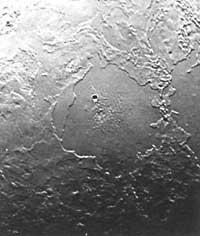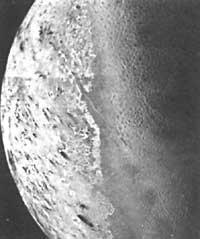Triton (II)
A
gold
After trying to clarify the physical characteristics of Triton in the number, we ended up with a suggestive hypothesis of its origin. On this occasion, as indicated then, we talk about the geological incidents of this satellite. For this we must remember this hypothesis. According to him, he would be a giant Comet conquered by Triton Neptune. We also mentioned the tidal forces as an energy source of their geological activity: the friction forces generated by the tide caused the warming of the core of Triton at the expense of the energy of their movements.
The dynamics caused by the warming caused the volatile gases that were trapped inside to be expelled forming atmosphere. On the contrary, the molten ice formed the surface and the heavier materials were silicated towards the core. However, when we talk about warming and these subsequent processes, we must take into account the value of the average temperature of Triton, without thinking that the efficiency of these processes may be what it would have in Earth conditions.
It is believed that the history of Triton's geological activity began three billion years ago. The main steps of the evolution described were in the first thousand or two thousand years, in which the activity calmed down a lot. The main causes of this evolution have been volcanic and seismic activity, but above all the first. Here, again, we do the previous note again. When we talk about vulcanism we should not take as a model the volcanoes of the Earth.
The pressure conditions and tritonic character only allow a particular form of vulcanism based on the phase changes of matter. Some call it “Cryobulcanism.” Below we will try to describe the main geological incidents that Voyager 2 has encountered in Triton and the explanations that have been given for them.
As is known, Voyager 2 approached Triton in the south. Therefore, this hemisphere and the equator environment have been the best studied regions. Three-quarters of the southern hemisphere are covered by nitrogen snow. As this hemisphere is about to enter summer, a large irradiation of sunlight has broken the layer of ice or snow. The process is not well known. Perhaps for something the environments were darker, receiving more light have melted. However, it seems more interesting the special dark saws (of colors between pink and brown) that have been observed in this same white layer. They are all oriented north by wind effect. It seems that they are signs of a form of the aforementioned volcanic activity, which is still quite common today.
These are phenomena that evoke terrestrial geysers: the so-called “ice geysers”. These eruptions would be the layers of snow themselves. In Triton conditions, the pressure of the ten-meter layer of snow and anxiety may be enough to melt the underlying nitrogen snow, forming liquid nitrogen bags. Like spring, and especially as summer progresses, the snow layer decreases, the pressure on these bags also decreases. Under these conditions any crack can be enough to aromatize the nitrogen and remove the nitrogen in the form of a jet with which it is above.

If the process described is of interest, it is even more interesting the origin of the reddish matter (of intermediate tones between pink and brown) that gives off the eruptions, that is, the origin of that matter that later remains as a trace. When sunlight and, above all, electrons trapped in the magnetic field of Neptune radiate the nitrogen that forms snow and small amounts of methane and other simple hydrocarbons, the components cited form complex organic sediments.
After the fall of snow in winter, the compounds would form mainly in spring and summer, but these do not evaporate like snow. Consequently, organic compounds accumulate in the place where they have been produced in each annual cycle, reaching appreciable amounts. This is the matter that emerges from the eruptions of nitrogen and forms the reddish saws. These compounds, which have also been seen on Titan, are composed of molecules such as those that 4,000 million years ago participated in the birth of life on Earth. Therefore, your analysis could help solve this problem.
For the structures described below we do not have a complete theory. Your understanding will also take a long time. Most of the surroundings of the equator of Triton are melon-shaped areas, formed by a network of superficial polygonal channels. Crossing these regions you can see other long and narrow spots. They would probably form when they emerge before breaking the surface and freezing the lower mud. This type of vulcanism was also discovered in the satellite Ariel of Uranus. Melon-shaped areas may be due to other types of vulcanism, but we know nothing about it. There are no meteor blows in this area. Therefore, this part of the surface is quite young.
This equatorial environment and the snow layer are separated by two types of territories. Some are very old, with numerous craters made by meteorites. The rest looks very rare. Apparently, the snow of the place has melted in the last year and you see large blue lakes of frozen methane.
In some regions of the northern hemisphere, lava flows can be seen. Triton lava is formed mainly with water and some other ammoniacal component, but it must be taken into account that at its temperatures the ice has the hardness of steel.
As you can see, in Triton we have a surprising world, and when you solve some problems that now have no explanation, surely we will have to take it back.
EPHEMERIS SUN
PLANETS
|





